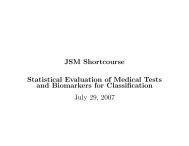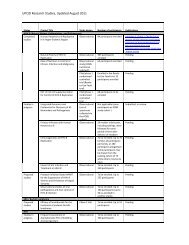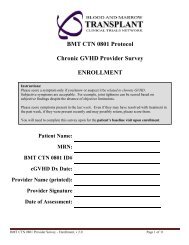Summer Undergraduate Research Program - Fred Hutchinson ...
Summer Undergraduate Research Program - Fred Hutchinson ...
Summer Undergraduate Research Program - Fred Hutchinson ...
You also want an ePaper? Increase the reach of your titles
YUMPU automatically turns print PDFs into web optimized ePapers that Google loves.
Antibody-Mediated Targeting of pH-Responsive “Smart Polymers”<br />
Facilitates siRNA Delivery to Cancer Cells<br />
Youcef Ouadah 1 , Maria C. Palanca-Wessels, MD, PhD 1 , Richelle Cutler-Strom, PhD 1 , Anthony J. Convertine, PhD 2 , Patrick S. Stayton, PhD 2 , and Oliver W. Press, MD, PhD 1<br />
1 Clinical <strong>Research</strong> Division, <strong>Fred</strong> <strong>Hutchinson</strong> Cancer <strong>Research</strong> Center, Seattle, WA; 2 Department of Bioengineering, University of Washington, Seattle, WA<br />
2010 Best Poster Presentation Award<br />
Conclusions<br />
Transcript Knockdown<br />
Assays Performed<br />
Abstract<br />
• Intracellular delivery of small interfering RNA (siRNA) molecules<br />
and target transcript knockdown can both be achieved with the novel<br />
polyplex system.<br />
Total RNA in SKBR3 Cells<br />
under polyplex treatment, 15nM siRNA<br />
Flow Cytometry: Cells were plated at 200 thousand cells per well and pulse-labeled<br />
for one hour with polyplexes containing 20nM AlexaFluor 647-labeled siRNA on ice.<br />
Cells were then washed with PBS and resuspended in DMEM + 5% FBS during<br />
incubation at 37°C. After specified incubation periods, cells were washed extensively<br />
with acid and PBS prior to flow cytometry analysis on a BD FACS Canto system.<br />
• Small Interfering RNA (siRNA) molecules are potent and specific<br />
inhibitors of gene expression in eukaryotic systems, including<br />
humans.<br />
neg. control siRNA<br />
anti-GAPD siRNA<br />
• siRNA internalization is dramatically increased in the Her2/neu<br />
expressing cell population and is dependent on anti-Her2/neu<br />
antibody targeting.<br />
Quantitative RT-PCR: Cells were plated at 50 thousand cells per well and treated in<br />
triplicate with polyplex containing 15nM siRNA for 48 hours prior to RNA extraction<br />
with an RNeasy Mini Kit (Qiagen). RNA was converted to cDNA using an ABI Taqman<br />
Reverse Transcription kit and PCR was performed using an ABI 7900HT Real-Time PCR<br />
system.<br />
• Delivery of pro-apoptotic siRNA to cancer cells may reduce<br />
tumor size and sensitize malignant cells to chemotherapy, however<br />
effective delivery to disseminated tumors remains a major<br />
obstacle1,2 .<br />
• GAPD transcript knockdown in SKBR3 breast cancer cells is<br />
increased under Her2/neu targeted polyplex treatment with low<br />
corresponding effects on global mRNA levels.<br />
Total RNA<br />
quantification data<br />
indicates little effect<br />
on global mRNA<br />
expression due to<br />
polyplex treatment.<br />
100<br />
80<br />
60<br />
40<br />
20<br />
0<br />
Percent RNA<br />
Relative to Untreated<br />
BHV1-SA 10H8-SA Trast-SA<br />
GAPD mRNA Expression in SKBR3 Cells<br />
under polyplex treatment, 15nM siRNA<br />
LDH Enzyme Activity Assay: Lactate dehydrogenase (LDH) activity provided a<br />
measure of cell viability and was measured using the Cytotoxicity Detection kitPLUS (Roche). Cells were plated in 96-well tissue-culture treated plates at 15 thousand cells<br />
per well and incubated continuously with drug at 37°C. Lysates were transferred to new<br />
plates at 1:5 dilution with PBS. The assay was performed as described in the kit manual<br />
and spectrophotometric measurements were taken at 492nm.<br />
• Monoclonal antibodies (mAb) Trastuzumab and 10H8 bind<br />
Her2/neu internalizing receptors overexpressed on ovarian and<br />
breast cancer cells allowing a mechanism for in vivo siRNA targeting<br />
and intracellular delivery3 .<br />
• Trastuzumab-SA targeting conjugate performs slightly better than<br />
10H8-SA in both internalization and knockdown studies.<br />
neg. control siRNA<br />
anti-GAPD siRNA<br />
• Dose-dependent cytotoxicity profiles demonstrate that SKOV3<br />
ovarian cancer cells are sensitive to carboplatin, paclitaxel, and 5fluorouracil.<br />
Results<br />
siRNA Internalization<br />
• An additional barrier to intracellular siRNA delivery is<br />
degradation of endosomal contents by fusion with the lysosome, so<br />
a pH-sensitive endosomolytic “smart polymer” (b-P7v6) has been<br />
developed to allow siRNA escape into the cytosol4 .<br />
Future Work<br />
140<br />
120<br />
100<br />
80<br />
60<br />
40<br />
20<br />
0<br />
Percent Expression<br />
Relative to Untreated<br />
158<br />
• Pulse labeling studies should be performed to demonstrate a more<br />
significant difference in target transcript knockdown between<br />
Her2/neu targeting and non-targeting conjugates and to better model<br />
in vivo delivery strategies.<br />
Significant GAPD<br />
transcript knockdown<br />
is observed in SKBR3<br />
cells with all tested<br />
conjugates but is<br />
highest with<br />
Trastuzumab-SA<br />
conjugate.<br />
NIH3T3 p185<br />
(Her2/neu+)<br />
NIH3T3 wildtype<br />
(Her2/neu–)<br />
BHV1-SA 10H8-SA Trast-SA<br />
p185 time 0 no treatment 88.5<br />
p185 time 0 no conjugate 90.9<br />
p185 time 0 BHV1 87.9<br />
100<br />
p185 time 0 Trast 88.9<br />
Cytotoxicity Assays<br />
80<br />
• In this study the mAb–”smart polymer”–siRNA polyplex is<br />
investigated for its ability to induce siRNA internalization through<br />
Her2/neu-mediated receptor endocytosis and to knockdown target<br />
mRNA transcripts.<br />
60<br />
% of Max<br />
• siRNA molecules targeting oncogene expression, such as antiapoptotic<br />
protein Bcl2, should be investigated to demonstrate<br />
knockdown-induced cytotoxicity.<br />
40<br />
• In addition, cytotoxicity profiles for relevant chemotherapeutics<br />
are generated in ovarian cancer cells as a foundation for future<br />
studies to demonstrate siRNA-induced enhanced chemosensitivity.<br />
20<br />
Targeting Conjugates<br />
no treatment (neg. control)<br />
no conjugate<br />
BHV1-SA<br />
10H8-SA<br />
Trastuzumab-SA<br />
Time: 0 hr<br />
Cells become<br />
sensitive to<br />
carboplatin at<br />
~10µM<br />
SKOV3 Cell Viability at 72 hours<br />
under carboplatin treatment<br />
120<br />
100<br />
80<br />
60<br />
40<br />
10 3<br />
APC-A<br />
0<br />
10 5<br />
10 4<br />
0 10 2<br />
Materials and Methods<br />
• Due to the modular design of the polyplex, targeting conjugates<br />
can be easily exchanged to investigate other cancer models, such as<br />
targeting CD22 surface antigens expressed in B cell lymphomas.<br />
p185 no treatment 1hr 97<br />
p185 no conjugate 1hr 96 20<br />
p185 BHV1 1hr 96.3<br />
p185 10H8 1hr 0 80.9<br />
p185 Trast 1hr 91.8<br />
Percent LDH Activity<br />
Relative to Untreated<br />
wt no treatment 1hr 90.8<br />
wt no conjugate 1hr 81.6<br />
wt BHV1 1hr 86<br />
wt 10H8 1hr 79.3<br />
wt Trast 1hr 77.2<br />
100<br />
100<br />
Time: 1 hr<br />
80<br />
80<br />
siRNA<br />
Condensing<br />
Cationic Block<br />
Polyplex<br />
formation<br />
60<br />
• Cytotoxicity assays should be performed in conjunction with<br />
polyplex treatment to demonstrate siRNA-induced enhanced<br />
sensitivity and to determine optimal chemotherapeutic dosages.<br />
% of Max<br />
60<br />
% of Max<br />
mAb-SA<br />
40<br />
40<br />
DMAEMA<br />
20<br />
References<br />
Paclitaxel’s<br />
mechanism of<br />
cytotoxicity<br />
changes at ~9nM5 .<br />
SKOV3 Cell Viability at 72 hours<br />
under paclitaxel treatment<br />
20<br />
10 3<br />
10 4<br />
APC-A<br />
0<br />
10 5<br />
10 3<br />
10 4<br />
APC-A<br />
0<br />
10 5<br />
0 10 2<br />
0 10 2<br />
biotin<br />
1. Ozpolat B, Sood AK, Lopez-Berestein G. Nanomedicine based approaches for<br />
the delivery of siRNA in cancer. J Internal Medicine 2009; 267: 44-53.<br />
2. De Fougerolles A, Vornlocher HP, Maraganore J, Lieberman J. Interfering with<br />
disease: a progress report on siRNA-based therapeutics. Nature Reviews Drug<br />
Discovery 2007; 6: 443-453.<br />
3. Slamon DJ, Godolphin W, Jones LA, Holt JA, Wong SG, Keith DE, Levin WJ,<br />
Stuart SG, Udove J, Ullrich A, Press MJ. Studies of the Her2/neu proto-oncogene<br />
in human breast and ovarian cancer. Science 1989; 244: 707-712.<br />
4. Convertine AJ, Benoit DS, Duvall CL, Hoffman AS, Stayton PS. Development of<br />
a novel endosomolytic diblock copolymer for siRNA delivery. J Control Release<br />
2009; 133: 221-9.<br />
5. Torres K, Horwitz SB. Mechanisms of taxol-induced cell death are<br />
concentration dependent. Cancer <strong>Research</strong> 1998; 58: 3620-3626.<br />
120<br />
100<br />
80<br />
60<br />
40<br />
20<br />
0<br />
Percent LDH Activity<br />
Relative to Untreated<br />
siRNA<br />
Relative Fluorescence Intensity<br />
Under Polyplex Treatment, 20nM siRNA-AF<br />
p185 (Her2/neu+)<br />
PPAA+DMAEMA+BMA<br />
mAb-targeted<br />
siRNA containing<br />
polyplex<br />
pH-Responsive “Smart” Block<br />
0 hour<br />
1 hour<br />
300<br />
250<br />
200<br />
150<br />
100<br />
50<br />
0<br />
Median RFI<br />
Relative to Untreated<br />
b-P7v6 polymer composition:<br />
• PPAA: poly(polypropyl acrylic acid)<br />
• DMAEMA: dimethylaminoethyl methacrylate<br />
• BMA: butyl methacrylate<br />
wildtype (Her2/neu–)<br />
Monoclonal antibodies are chemically conjugated to streptavidin<br />
(mAb-SA)<br />
Her2/neu targeted: Trastuzumab-SA; 10H8-SA<br />
Non-targeted: Bovine herpes virus (BHV1-SA)<br />
Acknowledgements<br />
Dose-dependent<br />
cytotoxicity curves<br />
demonstrate SKOV3<br />
sensitivity to three<br />
commonly<br />
prescribed<br />
chemotherapeutics<br />
in breast and<br />
ovarian cancer.<br />
SKOV3 Cell Viability at 72 hours<br />
under 5-fluorouracil treatment<br />
100<br />
80<br />
60<br />
40<br />
20<br />
0<br />
Percent LDH Activity<br />
Relative to Untreated<br />
Supported by: NIBIB R01 EB002991; Life Sciences Discovery Fund 08-02; NCI<br />
2K12CA076930-11; Lymphoma <strong>Research</strong> Foundation<br />
FHCRC <strong>Summer</strong> <strong>Undergraduate</strong> <strong>Research</strong> <strong>Program</strong> (SURP)<br />
Michael Press for supplying 10H8 monoclonal antibody and NIH3T3 cell lines<br />
Don Hamlin for supplying mAb-streptavidin conjugates<br />
Flow cytometry indicates that siRNA internalization is dependent on<br />
Her2/neu targeting and is optimized with Trastuzumab-SA conjugate.<br />
Cell lines used: SKOV3: Her2/neu expressing ovarian carcinoma<br />
SKBR3: Her2/neu expressing breast carcinoma<br />
NIH3T3 wt: non-Her2/neu expressing mouse fibroblast<br />
NIH 3T3 p185: Her2/neu expressing mouse fibroblast
















